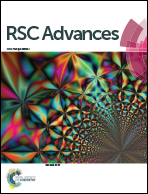Mechanism of atom economical conversion of alcohols and amines to amides using Fe(ii) pincer catalyst. An outer-sphere metal–ligand pathway or an inner-sphere elimination pathway?†
Abstract
In this present theoretical study, we investigated the reaction mechanism of atom-economical amide formation from alcohols and amines mediated by iron(II) hydride complex (iPrPNP)Fe(H)(CO) (iPrPNP = N[CH2CH2(PiPr2)]2) using state-of-the-art density functional theory. Two scenarios of mechanistic pathways were considered, the inner-sphere and the outer-sphere pathways. In former case, the reaction of encounter complex of formaldehyde with amine is the rate-determining step with ΔG298 K = 33.75 kcal mol−1 while as in latter case dehydrogenation from trans-hydride is the rate-determining step having ΔG298 K = 21.34 kcal mol−1. Both the mechanistic scenarios operate through stepwise ionic pathways. The assessment of computational results demonstrate that inner-sphere pathway is energetically demanding and thus rendering outer-sphere pathway to be the most plausible mechanism of amide formation. Ligand modifications reveal that electron-withdrawing groups like CF3 near N of PNP ligand reduce the catalytic efficiency of the catalyst. Furthermore, changing the isopropyl moiety of phosphine scaffold with CH3 has a minimal impact on catalytic activity of the catalyst. Overall, our computational results provide new insights for the design and development of new Fe(II) based pincer catalysts for atom economical amide formation from alcohols and amines.



 Please wait while we load your content...
Please wait while we load your content...